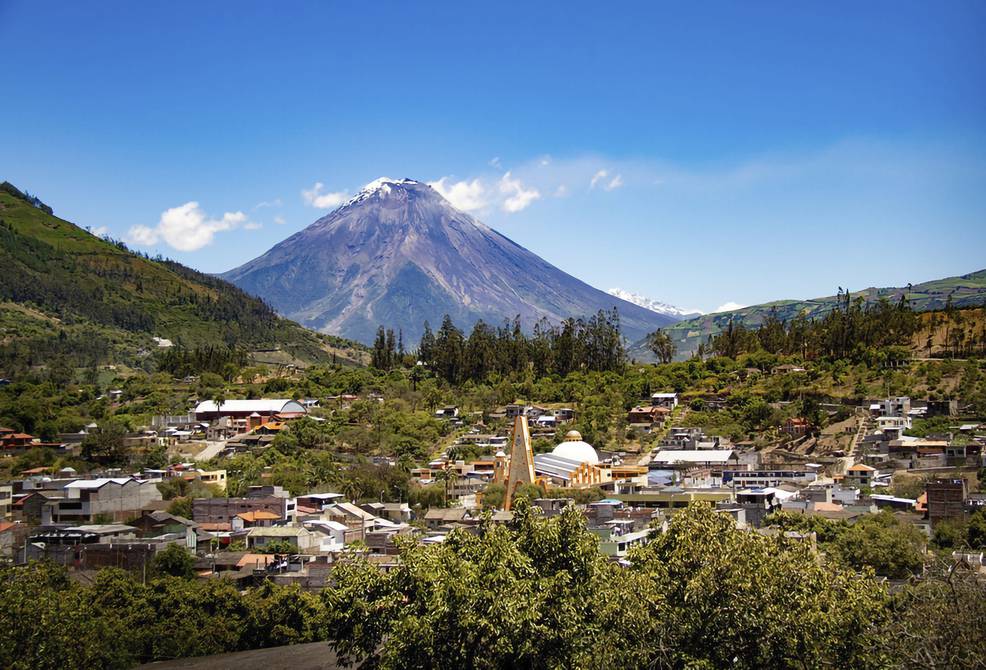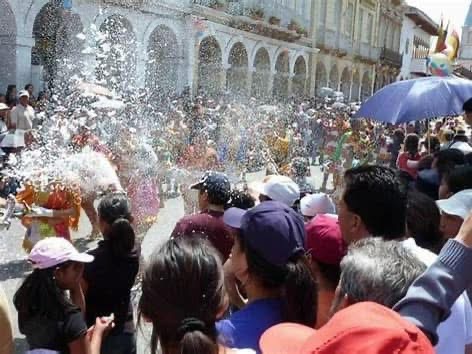Write a Post
Magical Towns of the Andean highlands
There are the 13 Magical Towns in the Ecuadorian Highlands. These towns are recognized by the Ministry of Tourism for their cultural, historical, and natural wealth, offering visitors a unique experience. Each town has a population of fewer than 100,000 inhabitants and meets specific criteria set by the Ministry.
Below is a list of the 13 Magical Towns located in the Andean highlands, along with their descriptions as provided by the Ministry of Tourism. The provinces they belong to are indicated in brackets.
Patate (Tungurahua): Known as the Valley of Eternal Spring due to its wonderful climate. The town is rich in cultural syncretism, reflected in its religious devotion to the Lord of the Earthquake.
Alausí (Chimborazo): Called the City of Five Heritage Sites, it features narrow cobblestone streets, Republican-style houses with flower-adorned balconies, and iconic landmarks such as the Devil’s Nose railway, the historic center, the town clock, nearby villages, waterfalls, and stunning landscapes.
Cotacachi (Imbabura): A city of contrasts, where churches, chapels, sculptures, and stained-glass windows blend with lagoons, trails, nature reserves, and productive farmlands. A stroll through its wide streets reveals its rich history and cultural diversity.
San Gabriel (Carchi): A religious tourism destination featuring the stunning La Paz Grotto, home to a giant cave, a suspension bridge, a tunnel, and three thermal pools. The area also boasts natural wonders like the famous Arrayanes Forest, Paluz Waterfall, and El Salado Lagoon.
Guano (Chimborazo): Known as Ecuador’s Handicraft Capital, Guano is renowned for its fine rug weaving. Surrounded by volcanoes and mountains, it offers breathtaking landscapes. A must-visit is the City Museum, which houses the mummy of a Franciscan friar.
San Antonio de Ibarra (Imbabura): A beautiful town famous for its skilled artisans, who have inherited the traditional craft of wood carving.
Rumiñahui (Pichincha): A historic valley rich in heritage, featuring a charming historic center and a main church. Visitors can admire adobe houses with tiled roofs, wooden balconies, and picturesque windows. The town’s spring-like climate and exquisite gastronomy make it a delightful destination.
Azogues (Cañar): Nestled in an inter-Andean valley along the Burgay River, Azogues blends modern and traditional architecture. It boasts 135 historical sites, including the Sanctuary of the Virgin of the Cloud, the Church of the Lord of Flowers, the Cathedral, museums, and cultural centers.
Chordeleg (Azuay): A town known for its colonial churches, adobe houses, and natural attractions like Pungohuayco, the Three Lagoons, Porrión Ecological Park, and the Tasqui Waterfall. Deep-rooted local traditions make it a fascinating destination.
Pimampiro (Imbabura): An ideal spot for family recreation and relaxation in a natural setting, offering Andean bear watching, adventure activities, and cultural experiences. For centuries, Pimampiro has preserved its intercultural identity, fostering harmonious coexistence among mestizos, Afro-descendants, and Indigenous communities who keep their traditions alive.
Calvas (Loja): Blessed with diverse climates, this productive canton boasts a variety of agricultural crops, including corn, vegetables, and high-quality coffee, contributing to a rich and varied gastronomy.
Cayambe (Pichincha): Known as the Land of Waterfalls, Flowers, and Mountains, Cayambe sits at the foot of the snow-capped Cayambe Volcano. It is home to a segment of the Qhapaq Ñan, a UNESCO World Heritage Site. Other highlights include the Middle of the World site, a deer breeding center, the Quitsato Solar Clock, Hacienda Guachalá, the Tingo Waterfalls, and the Guachalá Boulder.
Saraguro (Loja): This region features natural attractions such as Baño del Inka, Washapamba Cloud Forest, the Sleeping Lion, Salado de Turucachi, Putushio Hill, Chinchilla Lagoon, and Arcos Hill, offering a unique blend of history, culture, and breathtaking scenery.
Picture: Patate.

Air Europa will have direct flights to both Quito and Guayaquil this summer
Starting in June, Air Europa will introduce direct routes between its hub at Madrid-Barajas Airport and the airports of Guayaquil and Quito.
Beginning June 24, the airline will operate three weekly flights to each of these cities on a permanent basis. Until then, it will continue to operate its triangular route from Madrid. Air Europa has made more than 78,000 seats available on each of these routes this year—an increase of up to 8% compared to 2024—bringing the total number of seats available to Ecuador to over 157,000. Additionally, thanks to an agreement with Avianca, passengers will have access to domestic connections to Cuenca and Manta, as well as to the islands of Baltra and San Cristóbal in the Galápagos archipelago. Air Europa operates its transatlantic flights with the Boeing 787 Dreamliner.
Paute Entrepreneurs Turn Playing Cards into a Tourism Boost
Paute’s local entrepreneurs are getting creative in promoting their town as a must-visit destination. On Wednesday, February 19, the Azuay Tourism Front unveiled 5,000 custom decks of playing cards—each one packed with 54 unique designs showcasing the best of Paute. From traditional dishes and local businesses to natural attractions and festivals, these cards capture the heart of the canton.
Tourism entrepreneur Patricio Coronel shared an exciting twist—10% of the decks contain a special golden card, unlocking fun prizes like 250 pitchers of canelazo, 250 free entries to the recreation center La Cuchara más Grande del Mundo, and other surprises from local businesses.
These playing cards aren’t just for fun—they’re a perfect souvenir for visitors, giving them a little piece of Paute to take home while making their trip even more memorable.

Italian ambassador on crime in Ecuador: "The mafia business here is enormous"
The Italian ambassador to Ecuador, Giovanni Davoli, isn’t holding back when it comes to discussing the country’s crime problem. He links Ecuador’s growing insecurity to powerful organized crime groups.
Just two days after saying that the murder of an Ecuadorian Air Force lieutenant colonel was mafia-related, Davoli doubled down in a televised interview on February 19, 2025. Speaking on Teleamazonas, he made it clear: "The mafia business in this country is enormous."
He also pointed to an ongoing Italian-led initiative that’s training Ecuadorian justice officials and prosecutors on how to combat money laundering. "We know from experience that the way to hurt the mafia is to attack them where it hurts the most: their money," Davoli said.
Key takeaways from the ambassador’s remarks
"The mafia business here is enormous — equal to about 30% of the country’s GDP. Imagine the amount of money they need to launder."
"In southern Italy, we faced similar violence and clashes between the mafia and the state."
"Italy saw a turning point in the 1980s and 1990s when people started standing up to the mafia."
"Kids need to learn in school what the mafia is and why they should steer clear of it — it’s a huge threat to society."
"Police and prosecutors must be properly trained to understand how these criminal networks operate."
"There’s an Ecuadorian mafia and local groups working with regional and European crime syndicates."
"Most of the cocaine leaving Ecuador ends up in Europe — so who controls it once it gets there?"
Davoli’s comments come just after Ecuadorian President Daniel Noboa revealed that drug trafficking is a $30 billion industry in the country.
Source: Primicias.
Why is Cuenca so cold lately?
If you've been feeling extra chilly in Cuenca, you're not alone. The city is going through a particularly cold and rainy summer season, with temperatures dipping between 8 and 12°C in the mornings.
According to Rigoberto Guerrero, deputy manager of Environmental Management at ETAPA EP, the culprit is thick cloud cover, which blocks sunlight and prevents the atmosphere from warming up. That’s why the cold feels even more intense than the actual temperature.
More rain than usual
On top of the cold, Cuenca has seen above-average rainfall this February—90 to 110 mm, compared to the usual 60 to 70 mm. While the rainy season typically kicks off in March and April, this year it arrived early and stronger than expected.
Looking ahead, rainfall is expected to gradually increase through the first half of 2025, before giving way to a drier season from May to August.
Flooding and river alerts
The heavy rains have saturated the soil, increasing the risks of river overflows, landslides, and falling trees. As of February 17, 2025:
Tomebamba River entered a pre-alert phase.
Machángara and Yanuncay Rivers reached alert levels.
María Verónica Polo, ETAPA EP’s manager, warned that river levels will stay high and urged residents to avoid riverbanks, parks, and walkways until conditions improve.
Stay safe: precautionary measures
The Municipal Cleaning Company (EMAC EP) is advising residents to:
✅ Avoid standing under large or leaning trees.
✅ Keep the streets clean—don’t litter, as trash can block sewers and lead to flooding.
Rising river levels have already eroded riverbanks, increasing the risk of falling trees. Luis Quituisaca, a Green Areas Technician, assured that specialists are inspecting at-risk trees, prioritizing those near roads, schools, and parks.
If a tree poses an immediate danger, it's removed right away. Otherwise, a request must be sent to the Ministry of the Environment for authorization.
Road closure for tree removal
To prevent accidents, the Municipality has announced that Avenida 3 de Noviembre will be closed from February 19 to 21, between Avenida de las Américas and Los Cedros, from 7:00 AM to 4:00 PM for emergency tree removal. Alternate routes: Ordoñez Lasso, Ricardo Darquea, and Víctor M. Albornoz.
Is climate change to blame?
According to Guerrero, climate change is making extreme weather events more frequent. Cuenca has already seen a pattern of alternating between long droughts and intense rainy seasons.
For instance:
2023 had the longest recorded drought in Cuenca’s history.
2024 broke that record with 160 days of hydrological drought.
What used to happen once in decades is now happening year after year—a clear sign that climate change is reshaping the region’s weather patterns.
Source: El Mercurio.
Daniel Noboa announces 27% tariff on Mexican imports
On February 3, 2025, President Daniel Noboa of Ecuador declared the imposition of a 27% tariff on products imported from Mexico. This decision comes after Ecuador severed diplomatic ties with Mexico on April 5, 2024. Noboa stated that the tariff would remain in effect until a Free Trade Agreement (FTA) with Mexico is signed.
The primary objective behind this trade measure, according to Noboa, is "to promote our industry and ensure fair treatment for our producers." In a message posted on social media platform X, he emphasized that "the New Ecuador," a slogan of his administration, has always been open to commercial integration, but not when it involves abuse. He also expressed that his government is open to signing an FTA with Mexico, but until that happens, the 27% tariff will be enforced on imports from the North American country.
Under the previous administration of Guillermo Lasso, negotiations for a trade agreement with Mexico were 99% complete. However, in December 2022, both governments decided not to finalize the deal. Julio José Prado, Ecuador’s former Minister of Foreign Trade, explained that the negotiations were stalled due to the decision of Mexican President Andrés Manuel López Obrador, who refused to grant Ecuadorian bananas and shrimp preferential tariff access to Mexico.
Trade exchange between Ecuador and Mexico
Ecuador imports a range of goods from Mexico, including pharmaceuticals, machinery, mechanical devices, cars and their parts, electrical machinery, and cosmetics. These categories make up 57% of Ecuador's non-oil imports from Mexico.
On the other hand, Mexico imports approximately 320 products from Ecuador, sourced from 260 exporting companies, according to the Ecuadorian Federation of Exporters (Fedexpor). As a result, Mexico ranks as the eighteenth-largest destination for Ecuador’s non-oil exports.
Source: Primicias.
Cuenca's real estate sector grew by 18% in 2024
Cuenca's real estate sector has defied economic challenges, growing by 18% in 2024. Henry Astudillo, head of the Cuenca Chamber of Construction, explains the factors behind this growth.
Despite setbacks like power outages, Cuenca’s real estate market remained strong, with both new and ongoing projects thriving. The city’s safety and tourism appeal have made it a hotspot for investment, with private sector players keen on building plazas, shopping centers, cafes, and accommodation.
Land costs and housing demand have sparked a rise in high-rise developments, boosting urban density. Vertical construction has skyrocketed, with land use capacity jumping from 10% in 2023 to 93% in 2024.
Why is Cuenca attractive for real estate investments?
Cuenca’s reputation as one of Ecuador's safest cities has driven tourism and business investment, especially in the Historic Center. Many developers who had previously moved to larger cities have returned, bringing new investments with them.
“Everything comes back to tourism and security. Developers who left for bigger cities are coming back, bringing their money with them." — Henry Astudillo
The sector is growing steadily but still hasn’t reached pre-pandemic levels, with expectations for more growth in the coming years.
What projects are developers focusing on?
Vertical construction is on the rise due to high land costs, with more apartments being built than houses. Previously, 80% of developments were houses, but now apartments and houses are almost split 50-50. This trend reflects a shift towards denser urban living.
Tourism has also driven the growth of plazas and short-term rental options, like Airbnb units near the Historic Center. Meanwhile, Cuenca’s municipality is developing new hospitals and a shopping mall.
Which areas are expanding the most?
The eastern and southwestern parts of Cuenca are seeing the most growth, with key areas like El Ejido, Puertas del Sol, and Avenida Ordóñez Lasso experiencing strong vertical construction.
How are sales performing?
Sales have slowed due to Ecuador’s weak economy. While national numbers are even more challenging, Cuenca has remained stable.
Did power outages affect construction?
Yes, power outages did affect the sector, particularly for small and medium-sized construction companies. The full impact is still being assessed, but it was a tough quarter for the economy.
What challenges do developers face?
To attract investment, the sector needs political stability, legal security, and consistent government support. The government is currently working on 18 public infrastructure projects that require private investment, totaling around USD 8 billion.
Source: Primicias.
